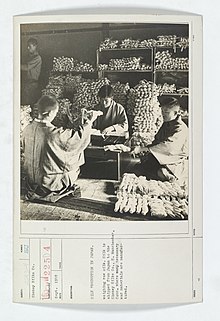17:
223:
82:
Between 1850 and 1930, raw silk ranked as the leading export for both countries, accounting for 20%–40% of Japan’s total exports and 20%–30% of China’s. Between the 1890s and the 1930s, Japanese silk exports quadrupled, making Japan the largest silk exporter in the world. This increase in exports
79:, where as late as the nineteenth and early twentieth centuries, Japanese exports competed directly with Chinese in the international market in such low value-added, labor-intensive products as raw silk.
102:, which led to the decline of the Japanese silk industry and its position as the lead silk exporter of the world. Today, China exports the largest volume of raw silk in the world.
56:
188:
227:
248:
91:
dynasty in China, which led to rapid industrialization of Japan whilst the
Chinese industries stagnated.
167:
168:"Why Japan, Not China, Was the First to Develop in East Asia: Lessons from Sericulture, 1850–1937"
71:
among
European silkworms devastated the silk industry there. This led to a demand for silk from
16:
8:
151:
134:
112:
43:. The silk industry was dominant from the 1930s to 1950s, but is less common now.
243:
237:
98:, embargoes against Japan had led to adoption of synthetic materials such as
95:
84:
40:
36:
68:
64:
52:
222:
99:
76:
72:
60:
32:
189:"Wallace Carothers and the Development of Nylon - Landmark"
88:
28:
152:
http://gallica.bnf.fr/ark:/12148/bpt6k3024c/f443.table
83:was mostly due to the economic reforms during the
235:
20:Silk Production in Japan - Weighing Raw Silk
67:Empire. However, in 1845, an epidemic of
35:. Archaeological evidence indicates that
15:
236:
162:
160:
13:
157:
55:had declined in importance after
14:
260:
215:
116:, wild silk moth species in Japan
221:
195:
181:
145:
127:
1:
120:
39:has been practiced since the
203:Business and Industry Review
7:
201:Anthony H. Gaddum, "Silk",
105:
10:
265:
207:In Encyclopædia Britannica
46:
87:and the decline of the
57:silkworms were smuggled
21:
19:
230:at Wikimedia Commons
249:Japanese inventions
22:
226:Media related to
113:Antheraea yamamai
256:
225:
209:
199:
193:
192:
185:
179:
178:
172:
164:
155:
149:
143:
142:
131:
264:
263:
259:
258:
257:
255:
254:
253:
234:
233:
218:
213:
212:
200:
196:
187:
186:
182:
170:
166:
165:
158:
150:
146:
135:"Japanese Silk"
133:
132:
128:
123:
108:
49:
12:
11:
5:
262:
252:
251:
246:
232:
231:
217:
216:External links
214:
211:
210:
194:
180:
156:
144:
125:
124:
122:
119:
118:
117:
107:
104:
48:
45:
9:
6:
4:
3:
2:
261:
250:
247:
245:
242:
241:
239:
229:
228:Silk in Japan
224:
220:
219:
208:
204:
198:
190:
184:
176:
169:
163:
161:
153:
148:
140:
136:
130:
126:
115:
114:
110:
109:
103:
101:
97:
92:
90:
86:
80:
78:
74:
70:
66:
62:
58:
54:
44:
42:
38:
34:
31:harvested in
30:
26:
25:Japanese silk
18:
206:
202:
197:
183:
174:
147:
138:
129:
111:
96:World War II
93:
85:Meiji period
81:
50:
41:Yayoi period
24:
23:
139:JapanTackle
37:sericulture
238:Categories
205:, (2006).
121:References
51:Silk from
69:flacherie
65:Byzantine
53:East Asia
175:Debin Ma
106:See also
154:Gallica
94:During
63:to the
47:History
171:(PDF)
100:Nylon
77:Japan
73:China
61:China
59:from
33:Japan
244:Silk
89:Qing
75:and
29:silk
27:is
240::
173:.
159:^
137:.
191:.
177:.
141:.
Text is available under the Creative Commons Attribution-ShareAlike License. Additional terms may apply.
